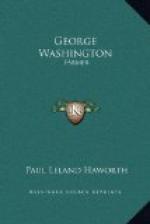After having set the wheels of government in motion he made an extended trip through New England and whenever public festivities would permit he examined into New England farm methods and took copious notes. On the first day up from New York he saw good crops of corn mixed with pumpkins and met four droves of beef cattle, “some of which were very fine—also a Flock of Sheep.... We scarcely passed a farm house that did not abd. in Geese.” His judgment of New England stock was that the cattle were “of a good quality and their hogs large, but rather long legged.” The shingle roofs, stone and brick chimneys, stone fences and cider making all attracted his attention. The fact that wheat in that section produced an average of fifteen bushels per acre and often twenty or twenty-five was duly noted. On the whole he seems to have considered the tour enjoyable and profitable in spite of the fact that on his return through Connecticut the law against Sabbath traveling compelled him to remain over Sunday at Perkins’ Tavern and to attend church twice, where he “heard very lame discourses from a Mr. Pond.”
About 1785 Washington had begun a correspondence with Arthur Young and also began to read his periodical called the Annals of Agriculture. The Annals convinced him more than ever of the superiority of the English system of husbandry and not only gave him the idea for some of the experiments that have been mentioned, but also made him very desirous of adopting a regular and systematic course of cropping in order to conserve his soil. Taking advantage of an offer made by Young, he ordered (August 6, 1786) through him English plows, cabbage, turnip, sainfoin, rye-grass and hop clover seed and eight bushels of winter vetches; also some months later, velvet wheat, field beans, spring barley, oats and more sainfoin seed. He furthermore expressed a wish for “a plan of the most complete and useful farmyard, for farms of about 500 acres. In this I mean to comprehend the barn, and every appurtenance which ought to be annexed to the yard.”
Young was as good as his word. Although English law forbade the exportation of some of these things—a fact of which Washington was not aware—he and Sir John Sinclair prevailed upon Lord Grenville to issue a special permit and in due course everything reached Mount Vernon. Part of the seeds were somewhat injured by being put into the hold of the vessel that brought them over, with the result that they overheated—a thing that troubled Washington whenever he imported seeds—but on the whole the consignment was in fair order, and our Farmer was duly grateful.
The plows appeared excessively heavy to the Virginians who looked them over, but a trial showed that they worked “exceedingly well.”
To Young’s plan for a barn and barnyard Washington made some additions and constructed the barn upon Union Farm, building it of bricks that were made on the estate. He later expressed a belief that it was “the largest and most convenient one in this country.” It has now disappeared almost utterly, but Young’s plan was subsequently engraved in the Annals.




